This was published 8 years ago
Public art in New York: An art lover's guide to the Big Apple
By Benjamin Law
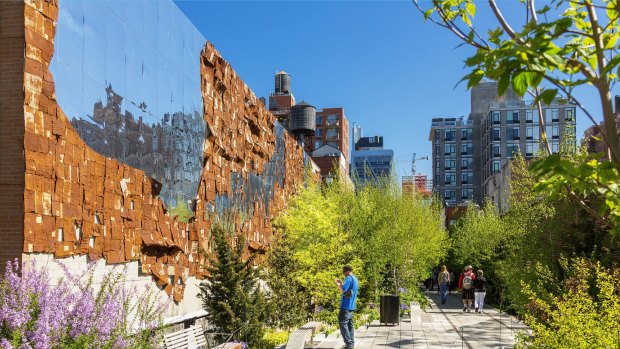
The High Line Public Park has become a magnet for art and nature lovers.Credit: Getty Images
Art fiends visiting New York have always been spoilt for choice. Still, even the most diehard culture aficionados can easily miss some of New York's best sculptures, mosaics and murals.
They aren't at the Whitney or Guggenheim, MoMA or Met, but hidden in plain sight, sitting tight in Chelsea's warehouses, oddly plonked on Manhattan's sidewalks, even below ground in New York's subway system. You just need to know where to look. And for that, you'll need a decent guide.
Darryl Reilly – a Manhattan local who also works as an actor – has been running a three-hour underground art tour of New York's subways since 2011. Over the rickety soundtrack of clopping metal and crunching gears, Darryl explains that half New York's subway stations boast public artworks designed by artists from all over the world. Some – like the Alice in Wonderland murals of 50th Street (where we start the tour) – are obvious. Others are literally blink-and-you'll-miss-it affairs.
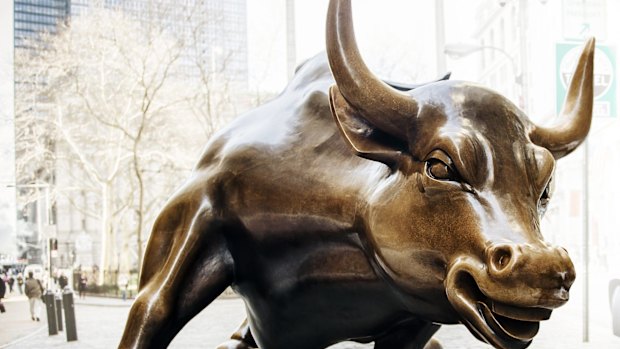
The Wall Street bull was left there one night, but public opinion forced officials to allow it to stay. Credit: Getty Images
"Sit on this side of the carriage and face that way," Darryl says, ushering us into a train that leaves the northbound platform of Dekalb Avenue station. As the train shoots off, we peer out into unknown blackness, uncertain of what we're looking for. Then the train whooshes past an abandoned railway station and in a flash – like magic – everyone is treated to a 20-second animated movie of a rocket launching into space.
What's really impressive is the animation isn't digital, but an optical illusion. Created in 1980 (then restored in 2008), Bill Brand's Masstransiscope is made of 228 hand-painted panels installed into the decommissioned Myrtle Station. When the train speeds past the panels and the columns in front of them, the entire set-up becomes a giant zoetrope for passengers, creating the illusion of movement. Most commuters on the train are consumed with their own business and don't even notice, but Brand's rocket is gasp-inducing for those who see it.
Darryl explains that artworks like these aren't just for show, but part of the New York's Metropolitan Transportation Authority's (MTA) broader rehabilitation scheme. As gnarlier subway stations are resuscitated and revived, the MTA has – since 1989 – called out for artists to submit proposals.
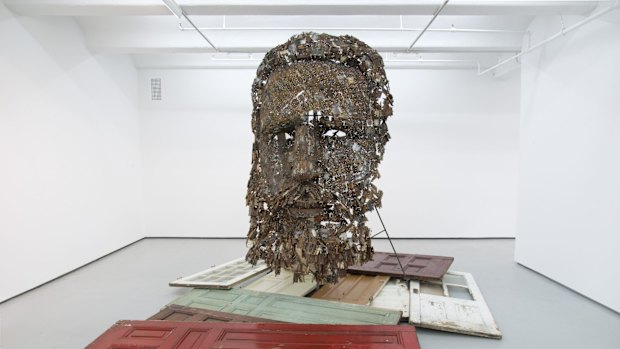
The Fidel Castro sculpture at the Jack Shainman Gallery was made by Yoan Capote from old door hinges.
Artworks can't be random. The MTA has strict parameters, insisting artworks must "create links to neighbourhoods with art". It's why the mosaics in 28th Street (a former toy district) depicts toys from the past, present and possible future, and why Canal Street (the main subway stop for Chinatown) has gorgeous mosaics representing goods historically traded between the United States and China.
However, like most people who go on Darryl's tour, everyone's hands-down favourite is Life Underground, a series of brass sculptures dotted throughout 14th Street and 8th Avenue Station. These adorable, blobby, cartoon-like characters are a hit with curious kids and adults alike, but Tom Otterness' sculptures are also vicious satires on the relentless grind of American capitalism.
Look closer, and you'll see Otterness' obese Monopoly-ish men growing ever fatter from progress on top of the station's stairs, while hapless workers are crushed by various industrial disasters below.
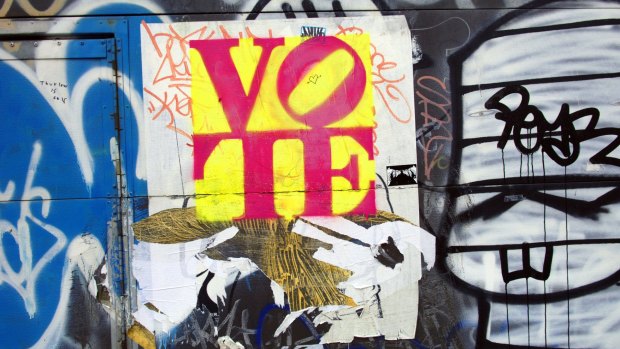
A stencil on a wall in the trendy art gallery district of Chelsea in New York City.Credit: Alamy
After Darryl's tour, we change over to 23rd Street station to meet Merrily Kerr, one of New York's most established art tour guides. Merrily, who has lived in New York for 16 years and has been showing tourists and locals through museums and galleries for the past decade, offers dozens of tour options. If you're new to New York, though, Merrily recommends starting with her Chelsea art tour.
"It's more accessible, the production values are higher and you see art that is sometimes interactive," she says.
"There's a big wow factor in Chelsea."
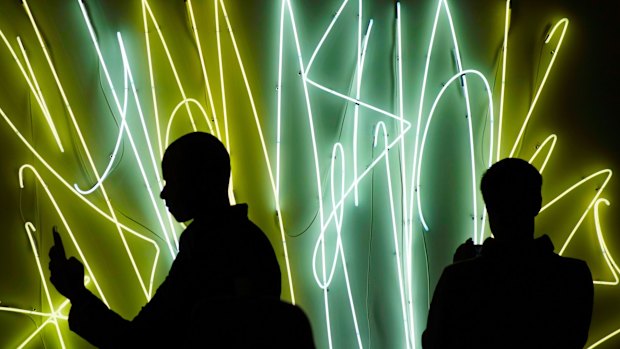
A neon gallery show in Chelsea in New York City.Credit: Alamy
Sometimes you can still find that wow factor on the Lower East Side galleries, too, Merrily says, but there's always a risk. "You might walk in a gallery, and there'll be a sheet of plastic on the floor and a piece of wood propped against the wall," she says. "I could explain it! But it tries people's patience a little bit."
Without Merrily's assistance, you could easily walk past some of Chelsea's cavernous warehouse-sized galleries and assume they're invitation-only showrooms. But, says Merrily, while all are privately owned, most are free to the public and contain blockbuster works that could compete against anything at the nearby Whitney Museum of American Art.
For the past decade or so, Merrily says, local galleries have been putting on museum-quality shows that warrant attention.
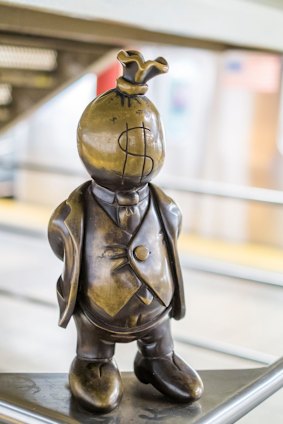
One of Tom Otterness' 'Life Underground' bronze statues in the 14th and 8th Street underground stations. Credit Alamy tra31newyorkartCredit: Alamy
When we visit the Jack Shainman Gallery, for instance, Cuban artist Yoan Capote has constructed a 2.4-metre high bust of Fidel Castro out of 3000 door hinges collected from his neighbours (after offering to replace their old ones with new ones), an impressive feat of engineering and socio-political commentary. Over in Larry Gagosian's gallery, Michael Heizer has somehow suspended a towering 18-tonne rock, excavated from the Mojave Desert, inside a 12-tonne steel frame.
It seems impossible – and possibly dangerous – that something so heavy should float above ground. Even so, nearly every visitor is tempted to look under the monolith by sticking their head underneath.
Merrily says one of the things she loves most about the Chelsea gallery district is how often shows change. "Every five to six weeks, there'll be a new exhibition at each of the galleries," she says. "So even if you're kind of up on the scene, you won't be in six weeks."
When Merrily's tour finishes, she recommends that we hoist ourselves upwards to walk the High Line, New York's now-famous and beloved two-kilometre stretch of abandoned rail-line. Now transformed into a floating walkway, lush with greenery, the High Line connects directly to the new Whitney Museum, which opened in May.
The art tour doesn't have to end at the Whitney, though. ArtWalk is a free app that geolocates your position anywhere in Manhattan and Brooklyn, and shows you the best public art nearby.
Some of the entries – such as Wall Street's charging bull – are iconic and obvious, but the app also volunteers the sculpture's official website, a timeline of its construction and related trivia. (Before using Artwalk, I had no idea the bull was installed in the middle of the night, in secret, not officially commissioned by the city or Wall Street, and stayed by popular demand.)
Artwalk also reveals architectural wonders and small hidden delights, and you can even ask it to lead you on a personalised art trail. It's user-friendly, effective and fun.
You can't escape New York's thumping art scene, even once the day's over. Throughout Manhattan and Brooklyn, there are dozens of art hotels dedicated to showcasing local works in its lobbies, rooms and restaurants.
The Quin – which is a hop away from both MoMA and Broadway – is one of the city's greatest. Best of all: if you like the artwork you see, it's all available to buy, which means you never need escape New York art again.
TRIP NOTES
MORE INFORMATION
GETTING THERE
Qantas flies direct to New York (JFK Airport) daily from Sydney. Flights from Melbourne to JFK run via Sydney or Los Angeles. Phone 13 1313, see www.qantas.com.au
STAYING THERE
The Quin, 101 West 57th Street, at Six Avenue, is an independent art hotel that showcases some of New York's best contemporary and emerging artists. Art on display can be purchased and it is only a short walk to MoMA. See www.thequinhotel.com.
DINING THERE
The Modern is a fine dining restaurant adjacent to MoMA, which offers three ($135) or four ($150) course menus, or a comprehensive tasting menu for $180. 9 W 53rd St, New York, see www.themodernnyc.com.
FIVE MORE GREAT SPECIALIST TOURS OF NEW YORK
BOROUGHS OF THE DEAD
A one-stop shop for every macabre tour in New York, Boroughs of the Dead offers dozens of tours, ranging from the Ultimate Greenwich Village Ghost Tour, Haunted Brooklyn Heights and Forgotten Dark Histories of Lower Manhattan.
See www.boroughsofthedead.com.
SOUNDWALK
Soundwalk bills itself as the provider of audio tours for people who don't usually like audio tours. A multiple international awards winner, the company's audio for the tours start at $140. Download the material from the website, and you're good to go.
See www.soundwalk.com.
SHOREWALKERS
For those looking for a gentler way to explore New York, Shorewalkers organises weekend walks by the water, exploring the city's bridges, aqueducts and beaches. Bring water: walks are usually several hours. Come in May for the Great Saunter, a 50-kilometre walk of Manhattan's waterfront and 20 parks in a single day.
See www.shorewalkers.org .
CENTRAL PARK CONSERVANCY
No one comes to New York City for nature, but visitors can spend entire days exploring Central Park alone. Central Park Conservancy volunteer guides offer 15 tours, ranging from "evening strolls" for romantics, "iconic views" for photography buffs and "northern forts" for history aficionados, which leads visitors through strategic sites of the American Revolution and War of 1812.
ACCOMPLICE
Orienteering nerds and fans of The Amazing Race will love Accomplice, where participants race through New York in a high-stakes mission. In groups of 10, participants track down clues and mysterious cast members who are strewn strategically throughout Manhattan and Greenwich Village.
Sign up for the Traveller Deals newsletter
Get exclusive travel deals delivered straight to your inbox. Sign up now.